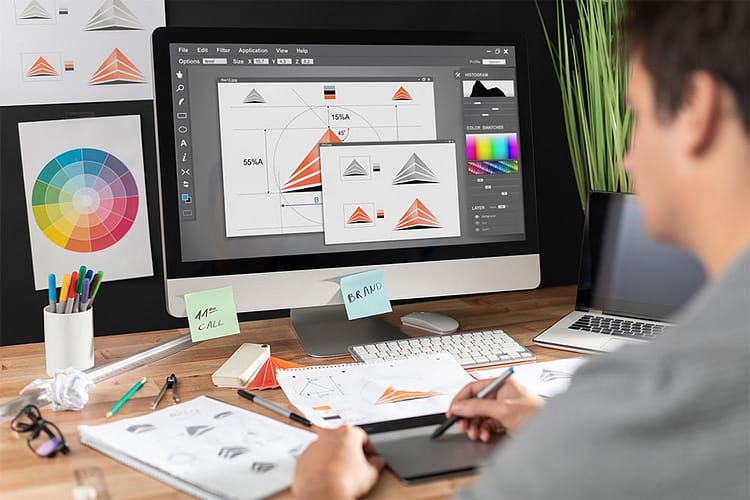Creative Tools for Graphic Designers
Dipublikasikan oleh Mawar pada
Creative Tools for Graphic Designers
Graphic design is a field that blends art and technology to create captivating visual communication. To produce professional-quality work, graphic designers need the right tools and software. This article explores the physical tools commonly used and the essential software relied upon by graphic designers.
Physical Tools for Graphic Design
While most graphic design is now done digitally, several physical tools remain essential to the creative process.
Computer or Laptop:
- A computer or laptop is the primary tool for graphic design. Opt for a device with high specifications, such as a fast processor, ample RAM, and a robust graphics card, to handle demanding design tasks.
- Recommended Options: iMac, MacBook Pro, Dell XPS, ASUS ROG.
Graphics Tablet:
- Graphics tablets allow designers to draw directly on a digital surface using a stylus. These tools are especially useful for creating illustrations or freehand designs.
- Recommended Options: Wacom Intuos, Wacom Cintiq, Huion Kamvas.
High-Resolution Monitor:
- A quality monitor is crucial for ensuring color accuracy in designs. Monitors with wide sRGB or AdobeRGB color coverage are highly recommended.
- Recommended Options: Eizo ColorEdge, Dell UltraSharp, BenQ PD Series.
High-Quality Printer:
- Printers with accurate color reproduction are essential for printing designs like posters, brochures, or business cards.
- Recommended Options: Canon PIXMA, Epson EcoTank, HP DesignJet.
Sketchbook and Drawing Tools:
- Before transitioning to digital, many designers start with sketches on paper. A notebook or sketchpad, along with pencils and markers, can be invaluable for brainstorming ideas.
Software for Graphic Design
Here are the most popular software options for 2D design, 3D modeling, animation, and more.
1. 2D Design Software
Adobe Photoshop:
- An industry standard for photo editing, poster creation, and digital design. Photoshop supports various image formats and offers advanced tools.
- Uses: Photo manipulation, digital design, and illustration.
Adobe Illustrator:
- A vector-based design tool ideal for creating logos, icons, and scalable illustrations.
- Uses: Vector design, branding, and illustration.
CorelDRAW:
- A vector-based alternative to Adobe Illustrator, widely used for print designs such as brochures and posters.
- Uses: Vector design and print layouts.
Canva:
- A beginner-friendly online platform with templates for quick and easy designs.
- Uses: Social media graphics, presentations, and posters.
Affinity Designer:
- A cost-effective alternative to Adobe Illustrator with robust vector design features.
- Uses: Vector design and illustration.
2. 3D Design Software
Blender:
- A free and open-source software for 3D modeling, animation, and rendering, used extensively by professionals.
- Uses: 3D modeling, visual effects, and animation.
Autodesk Maya:
- A professional-grade software for 3D animation and modeling, commonly used in the film and gaming industries.
- Uses: Complex 3D modeling and animation.
SketchUp:
- An intuitive 3D design tool often used in architecture and interior design.
- Uses: 3D modeling for architecture and product design.
3. Animation and Video Software
Adobe After Effects:
- A powerful tool for creating visual effects and motion graphics.
- Uses: Motion graphics and visual effects.
Adobe Premiere Pro:
- A professional video editing software ideal for creating ads, trailers, and presentations.
- Uses: Video editing and timeline management.
Toon Boom Harmony:
- A specialized tool for 2D animation, frequently used in animated films and cartoons.
- Uses: 2D animation.
4. Supporting Software
Adobe InDesign:
- A layout design tool perfect for publications like magazines, books, and brochures.
- Uses: Print and digital publication layouts.
Figma:
- A web-based platform for designing user interfaces (UI) and collaborating with teams online.
- Uses: UI/UX design and prototyping.
Procreate:
- An illustration app designed specifically for iPad, popular among digital artists.
- Uses: Digital illustration and painting.
Tips for Choosing Tools and Software
- Understand Project Needs: Choose tools and software that align with your design type, whether it’s illustration, print design, or animation.
- Budget Wisely: Some software like Adobe requires subscriptions, but free alternatives like GIMP or Inkscape are available.
- Check Compatibility: Ensure that your chosen tools and software are compatible with your hardware.
- Take Advantage of Free Trials: Many software options offer free trials—use these to determine which suits your needs best.
Conclusion
Having the right tools and software is essential for creating professional and efficient graphic designs. The combination of high-performance hardware and suitable software allows designers to bring their ideas to life effectively. By understanding the available tools and software, you can choose the best options for every graphic design project you undertake.

0 Komentar